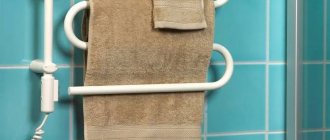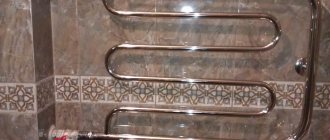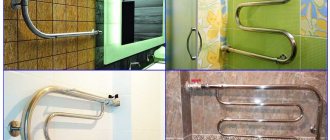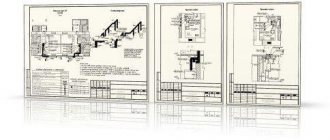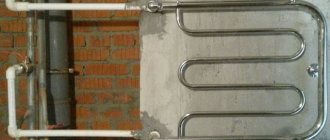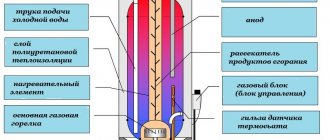Installing a heated towel rail in the bathroom has many advantages; it is useful not only in winter, but also in summer.
The device allows you to quickly dry towels and linen, and the very fact of additional heating of the bathroom, with its constantly high humidity, is a guarantee of the absence of mold and mildew, unpleasant odors and dampness, the appearance of which is possible throughout the year.
Typical construction projects at the end of the last millennium included equipping each bathroom with a device for drying towels.
Of course, the location and shape of the device itself were not always convenient for apartment owners, so when carrying out repairs or the need to replace an old device, the question of moving the heated towel rail to another wall often arises.
Types of heated towel rails and their advantages
Heated towel rail
Let us clarify that there are several types of heated towel rails, each of them has advantages, but they are not without some disadvantages.
Typically used devices:
- Standard water ones - work when connected to the hot water supply of a house or its heating system. The problematic nature of such a device is associated with the possibility of operation only during the heating season or when hot water is available. Otherwise, the device will be useless. The second point is difficulties with connection - illiterate implementation can have a negative impact on the operation of the water supply or heating system of the entire house.
- Electric heated towel rails are metal tubular structures with an electric heater inside. The big advantage of such a device will be the ability to work autonomously.
- Universal heated towel rail - Probably the most convenient and unpretentious option. It runs on both hot water and electricity. The only drawback will be the price of such devices - almost 2 times higher than standard models.
There are also very convenient portable electric models, they are installed on the floor, do not require any installation, they can be used not only in the bathroom, but in the kitchen or in the room, as a heating device.
Helpful hints
- The seamless steel model is recommended for installation in apartment buildings. This model will withstand increased liquid pressure in the pipeline, pressure surges, and changes in water flow speed.
- Brass appliances are installed in a house with an autonomous water supply.
- It is worth considering whether it is possible to mount the device on the border wall with the living room, or move the heated towel rail to another wall.
- When installing pipes in a riser, either threaded connections are used or welding work is performed.
- It is not advisable to use carvings in hard-to-reach places: behind decorative trim.
- It is necessary to slope the supply pipe towards the movement of hot water. This will ensure that there are no air traffic jams.
- A distance of 3.5-5.5 cm is maintained between the wall and the middle of the supply pipe.
If you do not want to seek the help of a specialist to move a heated towel rail in a water-type bathroom, then it is recommended to install an electric device. But then electricity bills will increase. The choice is yours.
How to choose a heated towel rail
When choosing an installation, you should pay attention to imported devices.
Models made in Germany and the Czech Republic are in demand on the market; they are of higher quality than those from domestic manufacturers.
When choosing, special attention should be paid to seamless models.
When choosing, we take into account that the best option is a product made of stainless steel or a more expensive one made of brass.
But if you live in a country house or cottage, you should trust the heating and drying of towels to models made of ferrous metal or brass. If the quality is good, such a device will last more than twenty years.
Let's watch a video on how to choose the best model:
General provisions
- prevents the appearance of fungus, mold and dampness;
- maintains normal humidity in the room;
- brings an aesthetic appearance to the bathroom;
- has functional significance.
It is prohibited to independently carry out the following activities:
- unscrew the nuts and cut off the bolts, dismantle the riser;
- carry out welding work;
- turn off water supply systems;
- prevent the flow of water into other residential premises;
- reduce water pressure by blocking water supply pipes.
Pay attention to the presence/absence of hidden pipes and electrical wiring. It is advisable to make the wiring “internal”. To do this, it is necessary to groove the walls and lay the cable during the repair process.
But this situation can be overcome by using a plastic box. All sockets must be closed and have a protective cover.
To do this, it is necessary to groove the walls and lay the cable during the repair process. But this situation can be overcome by using a plastic box. All sockets must be closed and have a protective cover.
Models with an electric power supply are very common on the construction market. It allows you to control the temperature: turn off the heating during your absence, or vice versa, turn it on in winter.
An electric heated towel rail requires alteration of the electrical wiring. Ease of installation, ease of operation, saving your money are the main advantages of electrical equipment.
It is important to know: in order to carry out repair work to move the heated towel rail, you must contact the local authorities to obtain permission.
For an apartment, it is best to purchase a water heated towel rail with a seamless design, as it can withstand any pressure changes perfectly. In private homes, brass ones are used - they are lighter and give off heat better.
Standards for transferring heated towel rails
The transfer of the device to another wall will not be assessed as a violation by the housing inspectorate, since the design is not indicated in the BTI plans and changing its position will not affect the configuration of the room layout.
Heated towel rail connection diagram
Other problems with transfer often arise, because the device belongs to common property and will require the collection of signatures for permission to transfer from all residents of the house.
But the device is not included in the BTI plans, and it works for each apartment separately.
At the same time, the water heated towel rail is fed into the heating or hot water supply system of the house and, if connected incorrectly, can affect its operation. All three points will need to be taken into account when carrying out repair work.
To correctly transfer the device, you will need to comply with some technical conditions.
| for water device | the wall on which the device is planned to be placed should not be adjacent to the bedroom or living room. The pipes used for connection must be either heating or heat-resistant, capable of withstanding high temperature and pressure. the device must be seamless and protected from water shock loads It is advisable to carry out the transfer at a minimum distance from the previous location |
| for electric | It is recommended to first calculate whether the permissible load on the electrical wiring of the apartment will be exceeded make sure there is a convenient outlet for connecting the device |
We should not forget the standards specified in SNiP:
- A stair-type heated towel rail is attached in such a way that an adult can reach the top bar;
- U-shaped is mounted no lower than 110 cm from the floor.
- M-shaped is placed at a height of at least 90 centimeters;
- The average mounting height is from 90 to 170 centimeters, for convenient use by a person.
Complex of preparatory work
Owners of electric models will have the least difficulties during transfer. They are completely autonomous and manipulation with them does not require additional capital investments or approvals from supervisory authorities. The actual dismantling and installation of the device is extremely simple and most often involves removing the device from one wall and attaching it to another. If necessary, the socket is additionally moved or grooves are made for wiring. This is where all the work ends.
With water equipment there will be much more hassle. To carry out the transfer of a heated towel rail, approval from the authorities responsible for the operation and condition of internal communications and buildings will be required. This is due to the fact that independent movement of heating appliances, and this includes a water heated towel rail, makes the owner responsible for changing the technical parameters of the system and its condition.
Water heated towel rail transfer diagram
Thus, if problems arise, claims will be made specifically to the owner of the property. As a result, it is strongly recommended that all changes to heating systems be formally approved.
Relocating a heated towel rail is best left to professionals.
When choosing new equipment, you must take into account that it should not put additional load on the thermal system. Therefore, it should only be a certified device, correctly selected for thermal power in strict accordance with the volume of the bathroom. The hydrodynamics of heating pipelines should also not be disrupted. Consequently, the device is installed without the formation of an air lock and without creating additional hydraulic support. All these conditions can only be met if the device is installed correctly, for which it is best to invite a specialist.
Do-it-yourself heated towel rail installation
Moving a heated towel rail to another wall - is approval necessary?
There are 2 ways to coordinate the transfer of a heated towel rail:
- If the house is undergoing renovation and redevelopment, then it is worth noting the transfer in the design documentation, which will need to be submitted for approval to the housing inspectorate, which will subsequently allow or prohibit the transfer;
- If you just want to start repairing and remodeling your house, then it would be better to move the device with the help of employees of the management company, who will enter the new location of the installation.
It is always worth coordinating the transfer with the relevant authorities. If there is a breakdown in the water supply of the entire house, only you will be to blame, since you did not coordinate the transfer with the housing inspection.
Before installing a new heated towel rail, you need to calculate whether it will put additional load on the heating system of the house. The device must be completely original and free of defects.
Fighting airlock
You need to start at the design stage of the heating circuit. You can combat air in batteries using the following means:
- Automatic air vent
- Air separator
- Mayevsky crane
The air vent works in conjunction with an overpressure relief valve. When air accumulates to a threshold level, the float rises, which triggers the valve to release excess pressure.
The separator is based on a metal mesh. The water flow breaks against the cells and air bubbles are released from the coolant. The air accumulates in a special tank with a valve. When the pressure reaches its maximum, the air reservoir is emptied.
The Mayevsky crane is a universal fitting. Using this device, you can release both air accumulated in the system and excess pressure. Unlike the devices described above, the Mayevsky crane operates in a completely manual mode. It is advisable to equip each radiator battery with this device, especially on the upper floors.
Regarding the air vent and separator, these devices operate in fully automatic mode. These devices are most often placed in front of the circulation pump to protect expensive equipment from the negative effects of air lock.
Please note that all the devices described above are applicable to closed circulation circuits in which the coolant moves under the influence of some motorized means (for example, a pump). In parallel with closed systems, you can also find open circuits
Such heating circulates under the influence of natural forces (temperature difference, gravity, etc.).
In heating systems with natural coolant circulation, there is only one way to deal with air pockets. We are talking about installing an expansion tank. The container is installed in such a way that air flows into the tank. Typically, the container is mounted on top of the heating system. If we talk, for example, about a private house, then the expansion tank is mounted in the attic.
Relocation of the structure as a design solution
The world is gradually leaning more towards minimalism, and therefore small and neat models are increasingly gaining popularity.
This device has many advantages:
- Great view;
- Takes up little space in the bathroom;
- Costs less;
- Due to its small size, if the pressure of hot water is poor, it will be just as hot
Of the minuses, it is worth noting that such a device is not suitable for all baths. For large baths, such a unit will be disproportionately small.
Heated towel rail as a decorative item
There are companies that produce heated towel rails to order. You can order a design service and make the device according to your sketch, the required dimensions and color. It will succinctly fit into the interior of the bathroom. Colored models look good in a bathroom whose interior has a bright color scheme.
For standard bathrooms, a stainless steel model is best.
The best place for installation would be above the washing machine. According to SNiP rules, the distance from a household appliance to plumbing equipment should not be less than 60 centimeters.
General provisions
Let's look at the main advantages of a heated towel rail in the bathroom:
- prevents the appearance of fungus, mold and dampness;
- maintains normal humidity in the room;
- brings an aesthetic appearance to the bathroom;
- has functional significance.
It is prohibited to independently carry out the following activities:
- unscrew the nuts and cut off the bolts, dismantle the riser;
- carry out welding work;
- turn off water supply systems;
- prevent the flow of water into other residential premises;
- reduce water pressure by blocking water supply pipes.
Pay attention to the presence/absence of hidden pipes and electrical wiring. It is advisable to make the wiring “internal”
To do this, it is necessary to groove the walls and lay the cable during the repair process. But this situation can be overcome by using a plastic box. All sockets must be closed and have a protective cover.
The design and type of pipes must be selected taking into account the free space, as well as technical capabilities. It has been noticed that the larger the heated towel rail heating area, the greater the load on the heating network and heating costs.
Models with an electric power supply are very common on the construction market. It allows you to control the temperature: turn off the heating during your absence, or vice versa, turn it on in winter.
An electric heated towel rail requires alteration of the electrical wiring. Ease of installation, ease of operation, saving your money are the main advantages of electrical equipment.
For an apartment, it is best to purchase a water heated towel rail with a seamless design, as it can withstand any pressure changes perfectly. In private homes, brass ones are used - they are lighter and give off heat better.
How to prepare for the job of replacing or moving a heated towel rail in the bathroom to another wall
First you need to prepare the tools:
- hammer drill
- drill bits for working on concrete
- electrical tester
It is advisable to prepare screwdrivers, a tape measure, a marker, and mounting brackets.
Convenient place to install a heated towel rail
It is worth choosing the right place for installation; as mentioned earlier, it is best to install the heated towel rail above the washing machine, about one hundred and twenty centimeters, and at a sufficient distance from the pipeline.
After determining the installation location, it is worth marking it with a marker. It is advisable that there is a power source (socket) near the installation site. But if there is none, then you will have to lay a separate wire for our device.
There are 2 ways to install a new socket:
- When completely renovating a bathroom, a reliable option would be to lay the wire under the cladding.
- You can also run the wire directly through the cladding, but this will not be as safe. The first option, although more complicated and more labor-intensive, will be much more reliable than the second.
After which you need to dismantle the device from its original installation site.
We make new holes in the marked place for the mounting system of the device. All that remains to be done is to install the mounting system and place the device itself on it. Afterwards do the finishing work.
We invite you to watch an interesting video about installing a new heated towel rail:
Dismantling the old installation
When the preparatory work is completed, it makes sense to begin dismantling the old heated towel rail. This is done in several steps.
- First you need to outline the locations of future cuts. They must be made exclusively vertically, so it is recommended to place marks using a level.
- You will need to cut the pipes using a grinder. This must be done when approaching the dryer. We should not forget that the cut should be as smooth and correct as possible.
- You will need to carefully cut down the fastening elements, and then remove the cut device from the room so that it does not interfere.
- The frescoes will need to be sharpened. You should make an angle of 45° to ensure maximum comfortable entry of the perch.
- After this, the pipe will need to be coated with machine oil. Next, you will need to make a carving using a tool.
At this stage, the dismantling work will be successfully completed. If you plan to dismantle a serial Soviet-style water heated towel rail, then you will need to start from the method in which it is connected to the main line. The dryer can be attached by coupling or welding.
Moving a water heated towel rail, what difficulties arise
Firstly, legal problems may arise with permission to move, and secondly, when moving a water apparatus, problems may arise with the load of the new structure on the water supply system of the house.
All other difficulties are not serious compared to the first two.
Before starting the transfer, be sure to turn off the supply riser. It is not recommended to do this yourself; it is better to entrust it to a professional plumber.
Typically, water devices do not have a heat control system, but you can install a ball valve on it, which will allow you to regulate the heating of the installation.
First of all, you should always find out whether moving a structure in a house is allowed. If not, then you definitely need to coordinate this with the relevant authorities.
If you transfer the installation and do not agree with the housing inspectorate, you will be held administratively liable. The case may go to court, and you will have to be punished or get off with a fine for a tidy sum.
Watch the video for an interesting and safe option for connecting a heated towel rail:
Features of installing an electric heated towel rail
Electric heated towel rail
It will be much easier for residents of private houses to choose a place to install the unit. Residents of apartment buildings have a limited number of options when choosing a location.
The electrical design will not cause much trouble when transferring to another wall. There is no need to coordinate the transfer of such a device with the housing inspector.
There are two nuances that exist when moving an electric heated towel rail:
- The distance from the water source must be at least 60 centimeters;
- Correct power supply.
The electric model has a large number of advantages over its water counterpart, here are a few of them:
- The closed circuit allows el. the heated towel rail must be in working order all year round.
- With such a device, you should forget such words as: corrosion, hard water and pressure drops.
- And of course the biggest advantage will be the ability to regulate the heating strength.
Methods to improve performance and safety:
- It is necessary to carefully hide the wiring that is connected to the heated towel rail;
- It is worth grounding the device due to the fact that it is installed in a room with high humidity;
- It is advisable to install an RCD (residual current device)
Scheme 1 lateral and diagonal connections, non-restricted and unbiased bypass.
The most effective connection for the vast majority of substations (exceptions will be added a little later) is with the supply of coolant to the upper part and the release of cooled coolant from the bottom. This can be achieved by using a lateral or diagonal connection with an unnarrowed and unbiased bypass.
Figure 12. Connection of a PS ladder operating on natural circulation, without narrowing and without bypass displacement. Lateral connection.
Figure 13. Connection of a PS ladder operating on natural circulation, without narrowing and without bypass displacement. Diagonal connection.
The schemes are equivalent; the diagonal version has practically no advantages over the lateral one.
This PS connection diagram is the most universal:
- Works in any direction of supply in the riser.
- It is completely independent of the circulation speed in the riser.
- There is no need to bleed air from the substation after turning off the water.
- The distance from the riser is arbitrarily large.
Conditions for the circuit to work:
- The lower outlet of the riser must be below the connection point to the substation, and the upper outlet of the riser must be above the connection point to the substation.
- It is necessary to observe the slope of the supply pipes (the direction is shown in the figure). To be certain, you can take a difference of 3...30mm per meter. More is better. At small distances from the riser (a couple of meters) and a large diameter of the supply pipes (PPR 32mm), strictly horizontal laying is permissible.
- There should be no “humps” (completely unacceptable, otherwise air will accumulate in them and circulation will stop) or dips on horizontal routes (allowed only within small limits; deep “holes” will serve as “pockets” for airing).
- With bottom feed, there should definitely be no narrowing between the bends! It will interfere with the operation of the PS until it becomes completely inoperable! With top supply, in extreme cases, it is permissible to narrow the bypass by 1 step of the riser diameter (we will consider this option in detail below), but it is not required for the operation of the substation.
- The diameter of the pipes to ensure maximum circulation is preferably at least DN20 (3/4" for steel, 25mm for good reinforced PPR), ball valves - at least 3/4". The practical maximum distance of the substation from the riser when using a plastic pipe with a diameter of 25 mm is approximately 4.5 meters.
- It is highly desirable to place the supply pipes in thermal insulation. In addition to the fact that this is mandatory when embedding any plastic pipes (provides mechanical protection and compensation for thermal expansion), such insulation can improve the performance of the substation in certain cases (sagging pipes or “holes” in them).
It is strictly prohibited to install any taps on the bypass - this is vandalism and harm to yourself and your neighbors. Overlapping or excessive narrowing of the bypass:
- a) Slows down circulation throughout the riser (the temperature of hot water drops from water collection points in apartments).
- b) Radically worsens the water pressure in all apartments located further in the direction of supply. And with a certain location of the hot water outlet - even to the vandal himself. Indeed, when the bypass is narrowed by one pipe size, its throughput becomes approximately half as large.
- c) Does not significantly improve the efficiency of the above scheme, and with a lower feed, even on the contrary, it interferes with the operation of the substation.
